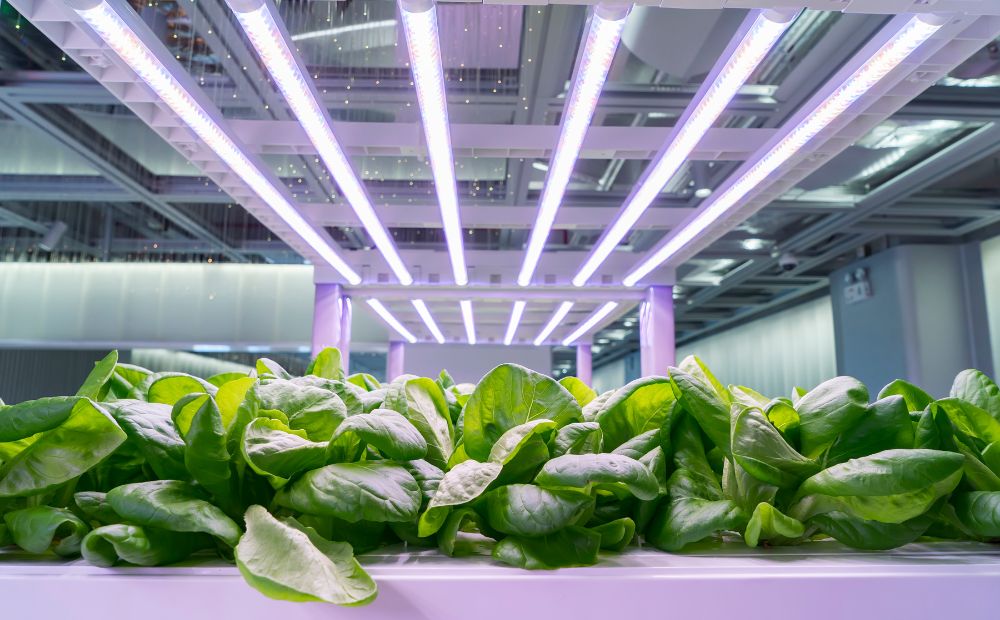
Introduction:
In recent years, the agricultural industry has witnessed a significant shift towards sustainable and efficient cultivation practices, driven by the need to meet the demands of a growing global population while minimizing environmental impact. Among the key innovations driving this transformation are LED grow lights, which offer a versatile and energy-efficient solution for indoor farming, greenhouse cultivation, and vertical farming operations. In this article, we will explore the latest advancements in LED grow lights and their transformative impact on modern agriculture.
Table of Contents

How LEDs Work?
LEDs are made from semiconductor materials, typically compounds like gallium arsenide, gallium phosphide, or gallium nitride. These materials are chosen based on their specific properties, including the energy bandgap, which determines the color of light emitted. When a voltage is applied across the semiconductor material of an LED, electrons are able to move from the conduction band to the valence band, releasing energy in the form of photons through a process called electroluminescence. The specific semiconductor material and doping determine the color of light emitted.
The Invention of LEDs (Light Emitting Diodes)
The invention of LEDs is credited to multiple researchers over several decades.
Here are key contributions:
Oleg Losev, a Russian inventor, is credited with creating the first LED. He published his findings on the phenomena of electroluminescence in diodes. Nick Holonyak Jr., while working at General Electric, developed the first practical visible-spectrum LED, specifically red, which is why he is often referred to as “the father of the LED.”
The Rise of LED Grow Lights:
LED (Light Emitting Diode) technology has emerged as a game-changer in agricultural lighting, replacing traditional lighting systems such as fluorescent and high-pressure sodium (HPS) lamps. LED grow lights offer several advantages, including higher energy efficiency, longer lifespan, precise spectral control, and reduced heat emissions. Light emitting diodes are used as artificial lighting sources in agriculture to help plants grow in controlled environments. LEDs can help improve crop quality and yield, flavor production, nutritional quality, photosynthesis efficiency, plant defense, and flowering. These features make them ideal for promoting plant growth, optimizing crop yields, and enabling year-round production in controlled environments.
Benefits of LED lighting
Here are some benefits of LED lighting in agriculture:
In agricultural applications, LED lights are used to change how plants grow, alter when they flower, transform how they taste, and even modify their levels of vitamins and antioxidants. LED lights can extend a plant’s shelf life as well. With the help of LED light modifications, two types of basil from the same plant can be grown. For example, we can grow sweeter as well as spicier basil on the same plant.
Extend Growing Season:
Artificial lighting can extend the growing season, allowing crops to be grown outside of their normal growing season. This capability enables growers to achieve impressive yields, producing up to 200,000 pounds of various crops including leafy greens, vine crops, herbs, and microgreens annually within a compact 12,000-square-foot warehouse. Remarkably, this output is equivalent to the yield of 80 acres of traditional farmland.
Energy Efficiency and Sustainability:
LED grow lights are significantly more energy-efficient than traditional lighting technologies, consuming less power while delivering higher light output. This translates into lower electricity costs and a reduced carbon footprint, making LED lighting a sustainable choice for indoor farming and greenhouse operations. Additionally, the longer lifespan of LED fixtures reduces the frequency of bulb replacements, further minimizing waste and maintenance expenses.
Prevent Physiological Disorders:
The monochromatic nature of LEDs can help prevent physiological disorders that are common in indoor environments.
Reduce Pest and Disease Pressure:
LEDs can help reduce the incidence of pest and disease pressure in agriculture, which could ultimately increase crop production efficiency.
Controllable Light Source:
LEDs can mimic the intensity, duration, and spectral distribution of sunlight, allowing farmers to provide ideal light conditions for plants to grow. Advanced LED systems allow growers to customize the spectral wavelengths emitted, providing optimal lighting conditions for photosynthesis, flowering, and fruiting. By fine-tuning the light spectrum, growers can enhance plant growth, improve crop quality, and maximize yields.
Adaptability and Versatility:
LED grow lights offer unparalleled flexibility and adaptability, allowing growers to create tailored lighting environments for a wide range of crops and growing conditions. From leafy greens and herbs to flowering plants and fruiting crops, LED systems can be optimized to meet the specific requirements of each crop, maximizing productivity and quality. Moreover, their compact size and modular design make them suitable for vertical farming and space-limited growing facilities.
Remote Monitoring and Control:
Modern LED grow lights are equipped with advanced features such as remote monitoring and control capabilities, enabling growers to fine-tune lighting parameters in real-time. Through smartphone apps or cloud-based platforms, growers can adjust light intensity, spectrum, and photoperiods to optimize plant growth and respond to changing environmental conditions. This level of precision and control empower growers to maximize yields, minimize input costs, and optimize resource utilization.
LEDs are used in various types of farming, including:
Indoor Farming:
LEDs play a crucial role in indoor farming operations, where natural sunlight may be limited or unavailable. Vertical farms, hydroponic systems, and indoor grow rooms rely on LED grow lights to provide plants with the necessary light spectrum for photosynthesis and growth.
Greenhouse Farming:
Greenhouse growers use LEDs to supplement natural sunlight or provide additional lighting during periods of low light intensity, such as winter months or cloudy days. LEDs offer precise spectral control, allowing growers to tailor light conditions to optimize plant growth and crop quality.
Vertical Farming:
In vertical farming, where crops are grown in stacked layers or vertical racks, LEDs are essential for providing uniform and efficient lighting to plants at different heights. LED grow lights are often used in conjunction with hydroponic or aeroponic systems to maximize space utilization and crop yields.
Urban Farming:
LEDs enable urban farmers to grow fresh produce in indoor environments or limited spaces, such as rooftops, shipping containers, or abandoned buildings. LED grow lights provide the necessary light spectrum for plant growth while minimizing energy consumption and heat generation.
Aquaponics and Hydroponics:
LEDs are used in aquaponic and hydroponic systems, where plants are grown without soil in nutrient-rich water solutions. LED grow lights provide the essential light spectrum for plant growth while minimizing water evaporation and heat buildup in the growing environment.
Notable Pioneers in LED Innovation
Several famous individuals have made significant contributions to the advancement of agriculture, including those related to LED lighting and indoor farming:
Dr. Toyoki Kozai:
A renowned plant physiologist, Dr. Kozai has conducted extensive research on controlled environment agriculture, including the use of LED lighting in vertical farming and plant factories. His work focuses on optimizing light spectra, intensity, and photoperiods to enhance plant growth and productivity in indoor environments.
Dr. Chieri Kubota:
Dr. Kubota is a leading expert in controlled environment agriculture and vertical farming. Her research explores the integration of advanced lighting technologies, including LEDs, to optimize plant growth, resource use efficiency, and crop quality in indoor farming systems.
Dr. Gene Giacomelli:
A pioneer in controlled environment agriculture, Dr. Giacomelli has been instrumental in developing innovative indoor farming systems, including the Lunar Greenhouse project for NASA. His work emphasizes the use of LED lighting and hydroponic techniques to sustainably produce food in space and terrestrial environments.
Study Finds Philips LED Lights Provide Improved Energy Efficiency and Production for Growing Food Crops in Space
University of Arizona and Philips Lighting collaborated to create improved lighting for plant production in Mars-lunar greenhouses.
Non-water-cooled LED lights used 56 percent less energy; more than doubling production of edible biomass per kilowatt-hour (kWh) compared to the previous water-cooled high-pressure sodium system.
University of Arizona Controlled Environment Agriculture Center
Kimbal Musk:
Entrepreneur and co-founder of Square Roots, an urban farming company, Kimbal Musk is passionate about revolutionizing the food system through technology-driven solutions. Square Roots utilizes vertical farming techniques and LED lighting to grow fresh produce year-round in urban centers, promoting local food production and sustainability.
Dr. Dickson Despommier:
A microbiologist and ecologist, Dr. Despommier is known for popularizing the concept of vertical farming. His book “The Vertical Farm: Feeding the World in the 21st Century” discusses the potential of indoor farming using techniques such as hydroponics and aeroponics, often incorporating LED lighting for sustainable crop production in urban environments.
These individuals, among others, have played pivotal roles in advancing the field of indoor farming and sustainable agriculture, leveraging technologies like LED lighting to address food security challenges and promote environmental stewardship.
Conclusion:
LED grow lights represent a revolutionary technology that is reshaping the landscape of modern agriculture. Their energy efficiency, spectral versatility, and adaptability make them indispensable tools for indoor farming, greenhouse cultivation, and vertical farming operations. As growers continue to harness the power of LED lighting systems, we can expect to see further advancements in crop production, sustainability, and food security, paving the way for a brighter and more sustainable future in agriculture.
Signup For AgriNext Conference Newsletter

